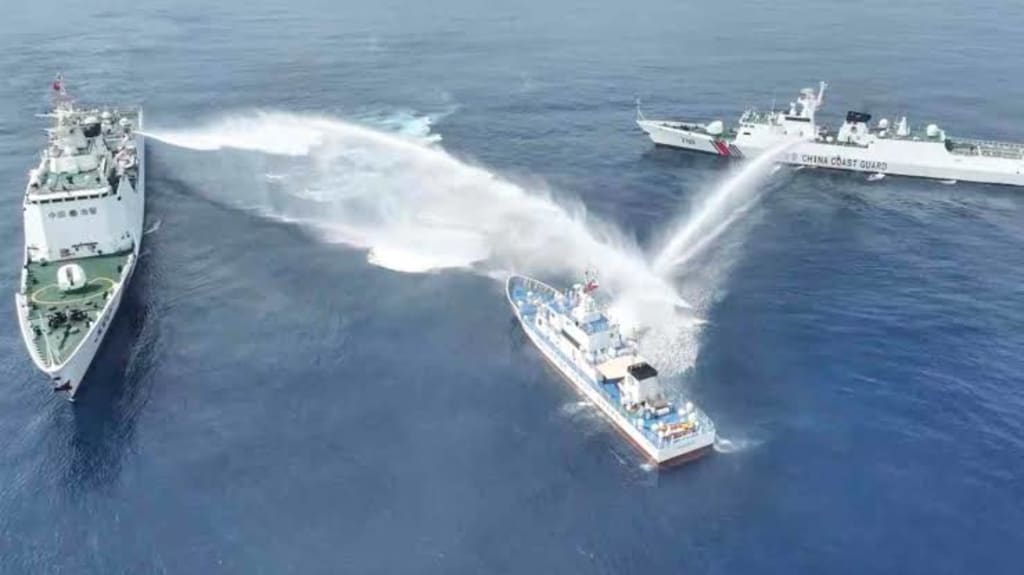Content warning
This story may contain sensitive material or discuss topics that some readers may find distressing. Reader discretion is advised. The views and opinions expressed in this story are those of the author and do not necessarily reflect the official policy or position of Vocal.

Let’s talk about the fight over the South China Sea. It’s rich in oil and gas, there are loads of fish and the shipping lanes are some of the busiest in the world. China wants control of it. But other countries say they have rights to it too. And the Americans — well they have trade routes through there worth hundreds of billions of dollars. So what’s behind China’s claim over these waters? Why won’t it share? And could it all lead to war? China has been a land-based power for millennia so it’s never had much of a navy so it’s never had much of a navy until now. Today China wants to be a naval force across two oceans the Indian and the Pacific. That’s to make sure it can trade with the rest of the world and get enough oil and gas to drive its economy. And to do that Beijing wants to control the South China Sea. But there’s a lot of competition. Taiwan, for one, claims many of the same rights that China does. Then there’s Vietnam, the Philippines, Malaysia and Brunei they want to protect their turf whether it’s rights to islands, seabed oil or fishing grounds. Indonesia’s in there too. And the Americans want to protect those valuable shipping lanes. So no shortage of players. The question is how is this all going to be resolved? And then there’s the third option which involves pushing some kind of compromise between China and its neighbours. Countries like Taiwan and others that are members of ASEAN have tried. But no one expects that to go anywhere anytime soon because China knows what it wants. And it’s been working towards that for a long time. We’re talking about China’s nine-dash line. Back in 1929 the Chinese took a bunch of old British sailing charts and told cartographers to draw China’s borders. One of them drew nine dashes around the entire South China Sea. And as far as the Chinese were concerned that was that. So then in 2013, China added a tenth line to take in Taiwan. So then in 2013, China added a tenth line to take in Taiwan. Its appetite seems to be growing. It’s easy enough to understand why China wants control when you look at the numbers. Around 40% of the world’s liquefied natural gas passes through the South China Sea — from the Gulf through the Indian Ocean and onto places like China. The amount of trade that sails through there is worth $3 trillion a year — one-third of the world's total. So there’s an expression in Latin that goes: If you want peace prepare for war. Now China has no immediate interest in war but it wants to ensure its access to the South China Sea if it comes to that. In the west, the main shipping lane from the Indian Ocean narrows to just 3 km. And it’s surrounded by American allies. In the east, there’s Taiwan which has tonnes of American weapons and could block China from getting to the Pacific. So to help stake its territorial claim China has planted its flag on contested islands that are in those waterways. In the Paracels China’s built a bunch of outposts while in the Spratlys it’s added over 13 sq km of reclaimed land since 2013 and turned them into military bases. It may be unacceptable to the Americans but neither the Obama nor the Trump administrations are seen to have accomplished much.The US’ main way of asserting navigational rights and freedoms is by having its navy sail through the South China Sea. It also conducts military exercises in the region sometimes with warships from France, Japan and Australia in the Bay of Bengal. In July things got a bit hairy. The Chinese and Americans both held naval exercises in the South China Sea. The US sailed in with two aircraft carrier strike groups. And the Chinese accused the Americans of escalating things. Before the US elections, the Trump team gave it one last shot — with mixed results. What everyone’s been trying to do is get China to obey the law — namely the UN Convention on the Law of the Sea. The law establishes what are called exclusive economic zones. These extend 200 nautical miles out from a country’s coastline regardless of whether it’s the mainland or an island. And China signed up to that law. So the Philippines did the only thing it could. It took China to court. One of the big issues was fishing rights. In 2013 the Philippines argued that China had no right to the Scarborough Shoal. It filed a case against the Chinese with an international tribunal at The Hague. Judges ended up siding with the Philippines. Remember China’s territorial claim based on that nine-dash line? Well in 2016 the court concluded that it’s invalid. Since the 1990s ASEAN that association of South Asian countries has tried to cobble together a Code of Conduct for the South China Sea. The idea was to control China’s ambitions. China hadn’t shown much interest in a code back then. But after losing the case with the Philippines the Chinese started to push for one. However, some in ASEAN questioned their motives. There’s another problem. Not everyone in ASEAN is eager to offend a country as powerful as China. Vietnam has repeatedly butted heads with China over their competing claims. This year’s ASEAN summit was hosted by Vietnam and a lot of it by video because of the pandemic. But the social distancing wasn’t expected to help delegates reach any agreements on the South China Sea. The problem with the South China Sea is that it’s vast and the stakes are high. There are a lot of heavily armed countries defending their interests there. And China’s coastguard as well as Chinese militia using fishing boats often cause confrontations on the open sea. Many analysts worry about all of that provoking a military response from someone. But strangely enough the whole dispute also sort of just bubbles away under the radar. The Chinese see the South China Sea as essential to their survival. The thing is it’s important to everyone there. That’s why this whole dispute isn’t going away. But China’s been around for thousands of years. If anyone is good at playing the long game, it’s China. As with all our Start Here episodes, this primer is to get us started. But there’s a lot more information out there to help us understand what’s going on in the South China Sea. As always subscribe wherever you’re watching this video and I’ll see you next week.





Comments
There are no comments for this story
Be the first to respond and start the conversation.